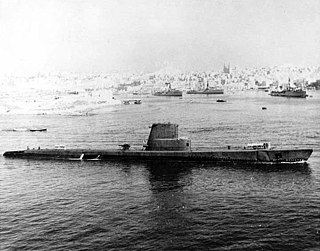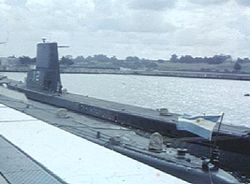
USS Bullhead (SS-332), a Balao-class submarine, was the last US Navy ship sunk by enemy action during World War II, probably on the same day that an atomic bomb was dropped on Hiroshima. She was the only ship of the United States Navy to be named for the bullhead.

ARA Santa Fe was an Argentine Balao-class submarine that was lost during the Falklands War. Built by the US during the Second World War, the ship operated in the United States Navy as USS Catfish (SS-339) until 1971 when she was transferred to the Argentine Navy. She served until 1982 when she was captured by the British at South Georgia after being seriously damaged and subsequently sank along a pier, with just her conning tower (sail) visible above the waterline. The submarine was raised, towed out of the bay and scuttled in deep water in 1985.

USS Puffer (SS-268), a Gato-class submarine, was the first ship of the United States Navy to be named for the puffer.

USS Becuna (SS/AGSS-319), a Balao-class submarine in commission from 1944 to 1969, was a submarine of the United States Navy named for the becuna, a pike-like fish of Europe. During World War II, she conducted five war patrols between August 23, 1944 and July 27, 1945, operating in the Philippine Islands, South China Sea, and Java Sea. She is credited with sinking two Japanese tankers totaling 3,888 gross register tons.

USS Chub (SS-329), a Balao-class submarine, was a ship of the United States Navy named for the chub, a game fish of the Atlantic and Mediterranean. The name is also given locally to a wide variety of American fishes. She was later transferred to Turkey where she served as TCG Gür.

USS Brill (SS-330), a Balao-class submarine, was a ship of the United States Navy in commission from 1944 to 1947. She was named for the brill, a European flatfish.

USS Lizardfish (SS-373), a Balao-class submarine, was a boat of the United States Navy named for the lizardfish, a slender marine fish having a scaly, lizard-like head and large mouth.

USS Chivo (SS-341), a Balao-class submarine, was a ship of the United States Navy named for the "chivo" or big-scaled goatfish Pseudopenaeus grandisquamis, a fish inhabiting the Pacific Ocean between Panama and Mexico.

USS Hardhead (SS-365), a Balao-class submarine, was a ship of the United States Navy named for the hardhead, a fish of the croaker family.

USS Hawkbill (SS-366), a Balao-class submarine, was the first ship of the United States Navy to be named for the hawksbill, a large sea turtle.

USS Guitarro (SS-363), a Gato-class submarine, was the first ship of the United States Navy to be named for the guitarro.

USS Hammerhead (SS-364), a Gato-class submarine, was the first ship of the United States Navy to be named for the hammerhead shark, a shark found in warm seas with a flattened anterior forward of the gill slits, presenting a hammer-like silhouette when viewed from above.

USS Icefish (SS-367), a Balao-class submarine, was a ship of the United States Navy named for the icefish, any member of the family Salangidae, small smeltlike fishes of China and Japan. These fish are also collectively known as whitebait.
USS Kraken (SS-370), a Balao-class submarine, was a ship of the United States Navy named for the kraken, a legendary sea monster believed to haunt the coasts of Norway.

USS Loggerhead (SS-374/AGSS-374), a Balao-class submarine, was a ship of the United States Navy named for the loggerhead, Caretta caretta, a very large, carnivorous sea turtle common in the warmer parts of the Atlantic, Pacific, and Indian Oceans.

The second USS Menhaden (SS-377) was United States Navy Balao-class submarine. Launched in 1944, she operated out of Pearl Harbor until 1946, then continued in use out of various ports in the Pacific until the 1970s. She was then decommissioned and re-fitted as a remotely controlled, unmanned acoustic test vehicle known as the "Yellow Submarine", until she was scrapped in 1988.

USS Macabi (SS-375) was a Balao-class submarine of the United States Navy, named for the macabi, a bonefish living in tropical seas and off the American coasts as far north as San Diego and Long Island and reaching a length of 3 feet (1 m).

USS Mapiro (SS-376), a Balao-class submarine, was a ship of the United States Navy named for the mapiro, a fish of the Gobioidea suborder occurring off the West Indies and the Atlantic coasts of Central America and Mexico.


















